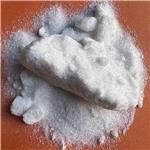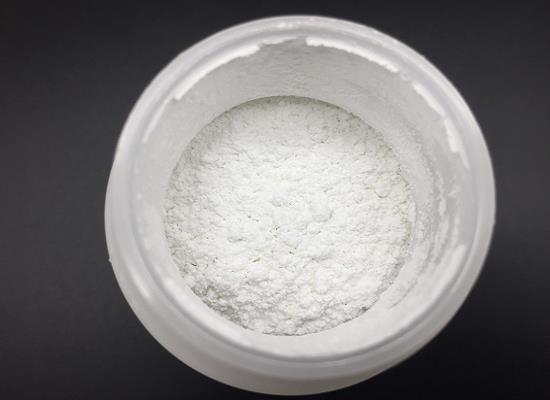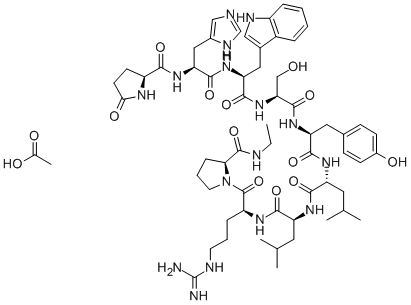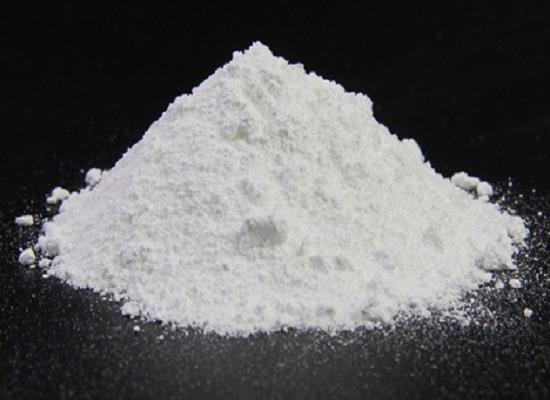Leuprorelin: pharmacokinetics, clinical applications and safety
General Description
Leuprorelin is a medication primarily administered parenterally due to its inactivation by intestinal enzymes when taken orally. It has a bioavailability of approximately 94% compared to intravenous administration. The sustained-release depot formulation releases the drug at a constant daily rate for about a month. Leuprorelin is used in the treatment of advanced prostatic cancer, endometriosis, central precocious puberty, uterine leiomyomata, and assisted reproductive technologies. Adverse events include changes in sex hormone levels, such as impotence and decreased libido in men, and flushing, headache, and vaginal dryness in women. Overall, leuprorelin has demonstrated efficacy but discontinuation may lead to symptom recurrence.
Figure 1. Leuprorelin
Pharmacokinetics
Leuprorelin is a medication that is primarily administered parenterally due to its inactivation by intestinal enzymes when taken orally. When given as a single subcutaneous dose of leuprorelin 1mg, peak plasma drug concentrations of 32 to 35 μg/L are achieved within 30 to 60 minutes. The bioavailability of leuprorelin is approximately 94% compared to intravenous administration. The elimination half-life is 3.6 hours, and total body clearance is 9.1 L/h. The sustained-release depot formulation of leuprorelin, which is administered subcutaneously or intramuscularly, releases the drug at a constant daily rate of 2.8% for about a month. After administration of depot leuprorelin 3.75mg and 7.5mg, transient peak plasma concentrations of 13.1 and 47.4 μg/L, respectively, are observed within 3 hours. However, plasma drug concentrations decrease significantly within 24 hours and remain between approximately 0.4 and 0.6 μg/L with monthly injections. Leuprorelin is metabolized into a (5-9) pentapeptide metabolite and possibly other peptide metabolites. It is primarily excreted in the urine, based on available animal and human data. 1
Clinical applications
Leuprorelin is a medication used for various clinical applications. In men with advanced prostatic cancer, noncomparative studies have shown that monthly depot injections of leuprorelin at doses of 3.75 mg or 7.5 mg, or daily subcutaneous injections at doses of 1mg or 10mg, result in partial response or stable disease rates ranging from 20 to 70%. These treatments are associated with improvements in subjective responses and performance status. For men with prostatic cancer, combined therapy using subcutaneous leuprorelin 1mg/day and oral flutamide, an antiandrogen, has been shown to increase median length of survival and progression-free survival compared to leuprorelin monotherapy. In women with endometriosis, monthly injections of leuprorelin 3.75mg or daily subcutaneous administration of leuprorelin 1mg have been found to significantly improve symptoms and endometriosis classification scores. Similar improvements have been observed with other medications such as danazol or buserelin. In children with central precocious puberty, leuprorelin administration has been effective in reducing mean growth velocity and preventing progression of sexual development markers. In women with uterine leiomyomata, monthly administration of leuprorelin 3.75mg has been shown to reduce uterine volume and improve fibroid-related symptoms. In assisted reproductive technologies, adjuvant treatment with leuprorelin has been associated with similar or increased numbers of mature oocytes retrieved and embryos available for transfer compared to cycles without leuprorelin. Pregnancy rates were comparable between treatment groups. Overall, leuprorelin has demonstrated efficacy in the treatment of prostate cancer, endometriosis, central precocious puberty, uterine leiomyomata, and assisted reproductive technologies. However, it is important to note that discontinuation of leuprorelin may lead to the return of symptoms in certain conditions. 2
Safety
The safety profile of leuprorelin varies depending on the patient's gender and clinical condition. Most adverse events are related to changes in sex hormone levels. In men receiving leuprorelin for prostate cancer, impotence and decreased libido are common side effects. Hot flushes occur in a significant percentage of men, and some experience an initial increase in prostate cancer symptoms. Coadministration of an antiandrogen can reduce these effects. In comparison to oral diethylstilbestrol, leuprorelin has fewer episodes of gynaecomastia, nausea/vomiting, peripheral edema, and serious complications. However, flushing is more common in men receiving leuprorelin. In women with endometriosis or uterine leiomyomata, flushing, headache, vaginal dryness, insomnia, and emotional lability are frequently reported. Leuprorelin can also cause a reduction in bone mineral density, which may be mitigated by "add-back" therapy with estrogen/progesterone or progesterone only. Children treated with leuprorelin for precocious puberty generally experience fewer adverse events, with localized reactions at the injection site being the most commonly reported side effect. 3
Reference
1. Periti P, Mazzei T, Mini E. Clinical pharmacokinetics of depot leuprorelin. Clin Pharmacokinet. 2002;41(7):485-504.
2. Plosker GL, Brogden RN. Leuprorelin. A review of its pharmacology and therapeutic use in prostatic cancer, endometriosis and other sex hormone-related disorders. Drugs. 1994 Dec;48(6):930-967.
3. Zhang S, Wang L, Zhang J, An W, Jia L. The efficacy and safety of Kuntai capsule combined with leuprorelin acetate in the treatment of endometriosis: A protocol for systematic review and meta-analysis. Medicine (Baltimore). 2021 Mar 19;100(11):e25080.
You may like
Related articles And Qustion
See also
Lastest Price from Leuprorelin manufacturers

US $0.00/kg2025-09-30
- CAS:
- 53714-56-0
- Min. Order:
- 1kg
- Purity:
- 98%
- Supply Ability:
- 1000kg

US $1.00/g2025-09-22
- CAS:
- 53714-56-0
- Min. Order:
- 10g
- Purity:
- 99
- Supply Ability:
- 999




